A herd of soldiers treads cautiously along a desolate lane. Pamphlets and pieces of papers float around like debris. One of these lands on the hands of a soldier who looks and sees the grim situation they’re in. In that moment, he’s our view into the world we’re about to enter. As Nolan’s audience, the situation is laid out in front of us through one shot of a map that shows the Allied forces cornered on the beaches of Dunkirk with the enemy approaching from all sides. Out of seemingly nowhere, shots are fired and we see the men fall and be taken down one by one until only one of them stands. He jumps over a closed gate, reloads his rifle after much fumbling and tries to retaliate by firing back at the German forces only to be scared by a shot fired back at him in return. In that moment of fear, he just ditches his rifle and scrambles towards the beach.
That’s precisely the kind of unpredictability and pragmatism Dunkirk dances around with throughout its run time. You have large groups of anonymous soldiers stranded on a beach awaiting to be rescued. With no character backstories whatsoever, you’re not sure who to root for. It almost inadvertently or masterfully helps build a different kind of suspense, one where you’re not entirely sure of who will survive because this story doesn’t have any stars to do service to. Everyone has an equal chance of survival. The opening sequence is one where any of the seven odd members could’ve been left behind – it just so happens to be Fione Whitehead’s Tommy.
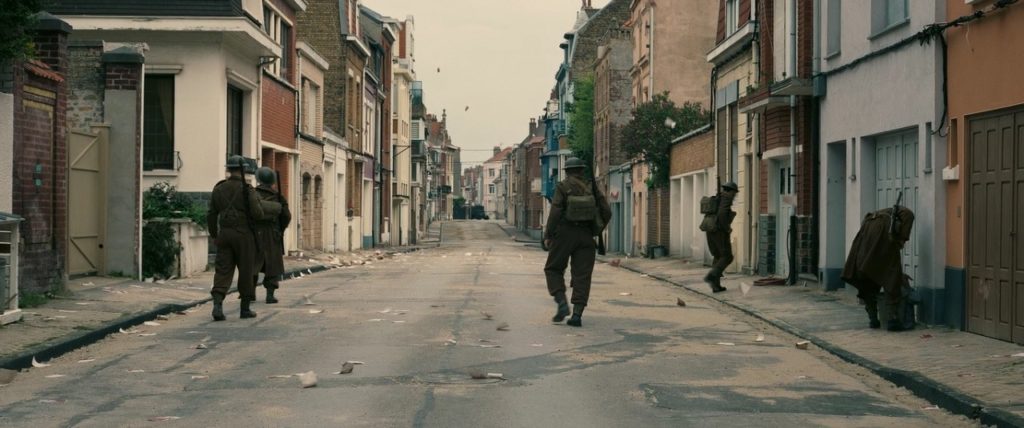
The opening scene sets the grim tone for the remainder of the movie
As the movie begins, we see the usual production house logos followed by the movie’s title displayed with uncharacteristic blandness typical of Nolan. That’s about the only cliched thing you’re going to see in this unconventional movie and the fact that it’s the title appearing before the start of a Christopher Nolan film is saying something.
To fill in the uninitiated, Dunkirk is based on a true story, the real Dunkirk evacuation that led to around 338,000 men being rescued from the beaches of Dunkirk between May 26 and Jun 4, 1940. That there were 400,000 Allied soldiers trapped in that long stretch of beach speaks to the criticality of the situation – practically the entire British Army had been rather foolishly sent to assist the French to fight off the German invasion and ended up being stranded there. Fortunately for them, the German High Command decided against using their Panzer tanks to approach and finish off the British Expeditionary Force (BEF), the French and the Belgian troops in order to save themselves some firepower, and instead gave the German spitfires some time to do the job. This additional much needed time proved to be a boon in helping the British plan Operation Dynamo which saw them attempt to evacuate as many men as quickly as possible.
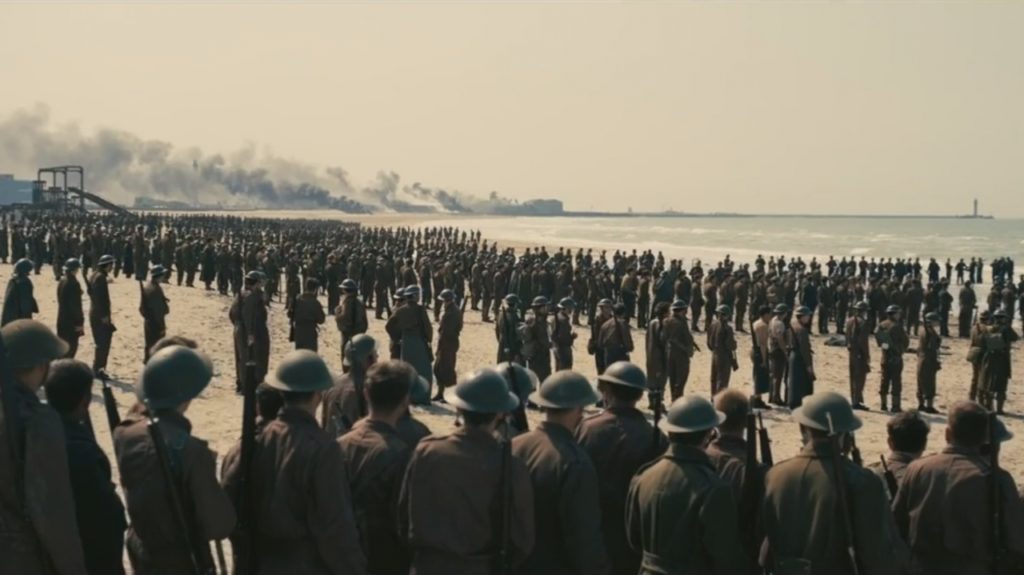
400,000 British, French and Belgium Men trapped on the Beaches of Dunkirk
We do see part of that discussion take place on a stretch of pier around Dunkirk. Kenneth Branagh’s Commander Bolton is seen confronting the enormity of the depressingly situation. They can practically see home from where they’re standing and yet, the numbers work against them. Getting out 400,000 is going to be impossible. That he hopes for 35,000 – 40,000 to make it out at the most is indicative of the difficulty of the situation, and also the eventual significance of the final outcome which subsequently came to be referred to as the Miracle of Dunkirk.
Nolan has eschewed several traditional war-movie elements in making this movie. For starters, we’re surrounded with mostly anonymous characters in that we either barely know the backstories of the people involved, or mostly don’t care save of course for Mark Rylance’s Mr. Dawson and his sons Peter and George. To that effect, Nolan casts mostly unknowns as soldiers seeing as they were young and inexperienced; that’s also how the controversial Harry Styles casting comes into play. Instead of manipulating our emotions and making us feel sympathy via moving music or touching anecdotes, Nolan thrusts us in the driver’s seat giving us three different perspectives to see the war from – land, sea and air. All three are separated by temporal differences, with the events in the different terrains taking place over the course of a week, a day and an hour respectively. These timings are no arbitrary numbers either – it took around a week for the evacuations to complete, it would’ve taken around a day for the boats to make the journey from the shores of England to the sands of Dunkirk (as was confirmed by Nolan himself when he undertook a similar journey with his wife for researching the movie, a journey which took 19 hours) and with the 70 gallons of fuel that the spitfires had left, they would’ve certainly been unable to last for more than an hour in the air. This is but one of the many examples of fine detail that the movie is filled with. And such details only add to the realism that Nolan wishes to portray.
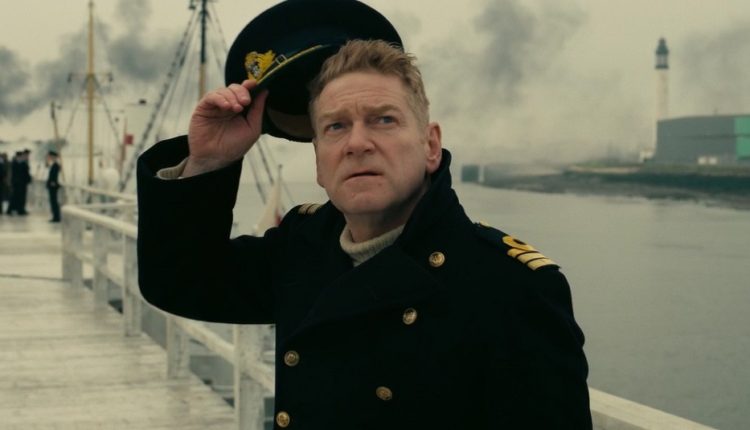
Kenneth Branagh, Mark Rylance, Cillian Murphy and Harry Styles turn in fine performances in Dunkirk
In fact, Nolan isn’t satisfied by these details and goes a step further to assemble actual ships to be a part of filming. The large destroyers in the movie were real ships refurbished for use in shooting. As also were the planes that were seen engaging in dog fights. To ensure that the air-fight sequences look and feel real, CGI just wouldn’t cut it. And so the masterful filmmaker and his skilled crew figured out a way to insert and place cameras onto the planes and have them flown in the air performing those maneuvers. The end result is that the groovy dance we’re witness to in the sky is the real deal, it’s as close to sitting safely in a spitfire cockpit as you can get. That with some truly skillful editing by Nolan’s longtime collaborator Lee Smith ensures we see some of the (maybe the) best aerial dogfights ever in cinematic history.
Focusing heavily on point-of-view direction, the movie feels a lot like an attempt to make you go through the harrowing motions of war. And it succeeds enormously in that regard. Right from lengthy uncut takes in the opening sequences of Tommy and Gibson carrying a wounded soldier on a stretcher, to the cockpit views in the air when Collins and Farrier attempt to take down German spitfires to the destroyer cramped with soldiers that topples and sinks when bombed with German airplanes to the small group sitting tight inside a claustrophobic ship awaiting the tide only for their ship to become target practice for the Germans, all scenes have a constant tension, palpable intensity and a sense of utmost urgency to them. It’s almost as if the entire movie is a final act of escaping from the prison that Dunkirk is about to become.
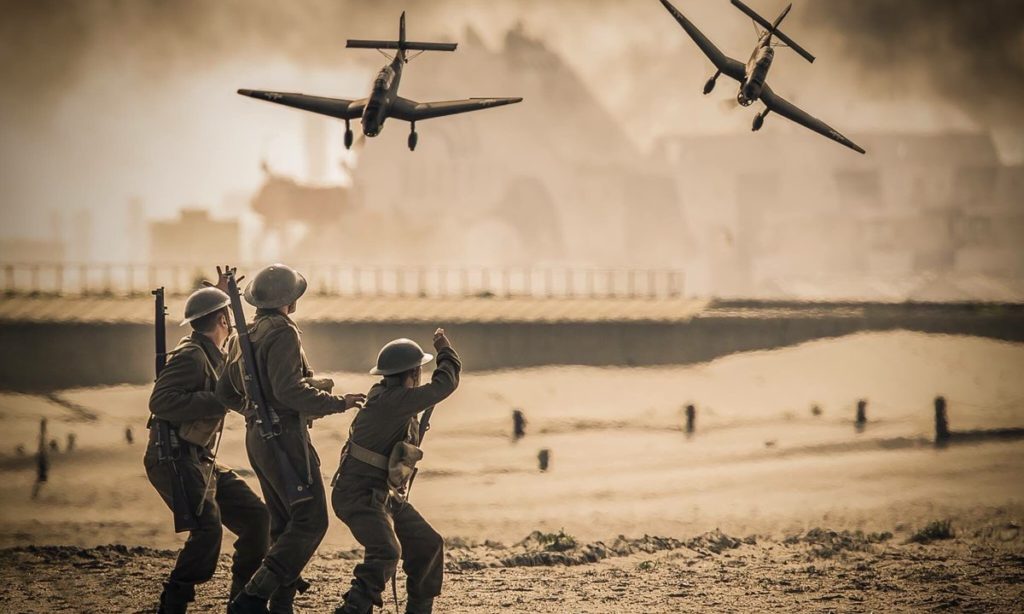
A group of soldiers duck from upcoming spitfire planes
But for a movie about mostly anonymous people, it carries some (unexpected) emotion as well. We fear when we see Farrier’s plane gauge broken and his fuel count decreasing until it hits 15 gallons, forcing him to switch to reserve and we hold our breath as he makes that fateful landing towards the end. We empathize when we see Cillian Murphy’s unnamed “Shivering Soldier” afraid to go back to the hell he had somehow managed to escape from. We pity Mr. Dawson who loses his son George on his way to help his country’s soldiers after having already lost a son to war and we tear up when we see George posthumously achieve his dire wish of doing something significant and finally getting that wish when he ends up in the news paper declared a hero. None of these moments are contrived; they just so happen to seamlessly blend into the movie’s plot.
Aside from being visually and emotionally strong, the film is truly a technical marvel of some fine video and audio wizardry. Shooting the film in IMAX could be one of cinematographer Hoyte Van Hoytema and director Christopher Nolan’s most impactful decisions; the scenes gain an unparalleled clarity that would otherwise be missing from normal theatrical prints. One really has to see the film in an IMAX theater to believe it. I personally saw it in Digital IMAX and was still blown away when the first frames showed up covering the entire screen; I can only imagine what the impact would’ve been like in traditional and true 70 mm theaters. It was Nolan’s first movie I was able to catch in IMAX and with around 75% of the movie being in that format, the experience was totally worth it. Accompanying the visuals was Zimmer’s ticking tension-building score which despite many negative reviews, I thoroughly enjoyed. The sound of a ticking clock (taken from Nolan’s personal wrist-watch) served as a constant reminder of time running out for each of the different view points and it was especially fearful for the fighters up above.
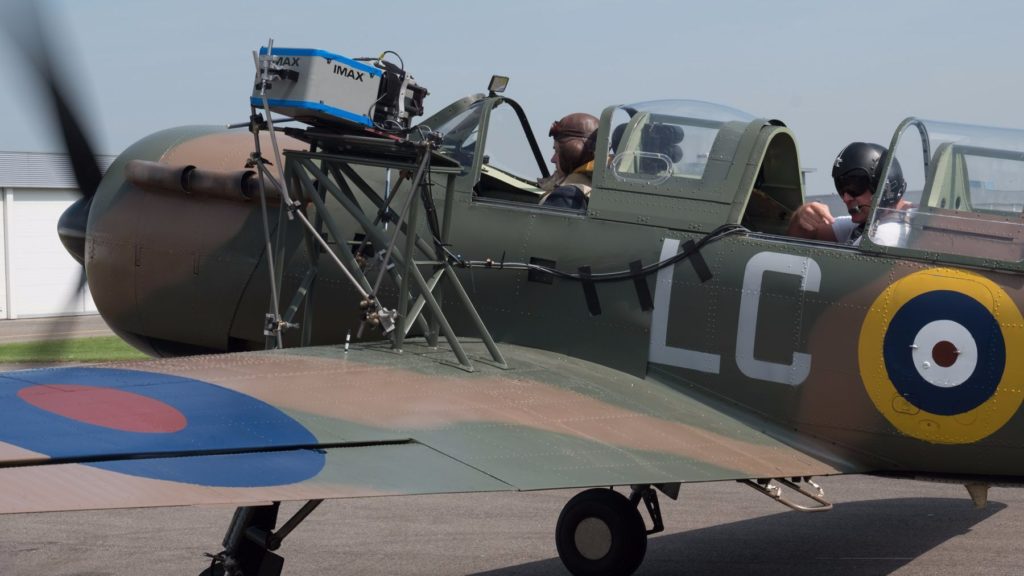
For the spitfire scenes, Nolan used real planes and put an IMAX camera in them to capture different points of view
It’s hard to imagine Nolan being able to do anything wrong at this stage. That said, the movie did leave me wanting for some more character connect and the exposition to the situation that typically comes with Nolan movies (Inception, Interstellar). And while it was understandably not the movie’s intent, it would’ve certainly helped us connect better with our fellow comrades on screen. Nolan kept things rather intimate, personal and minimalist in his 76-page screenplay in that he followed the journey of a small group of people among arguably many such battles that would be proceeding in parallel. I guess then my only gripe of Dunkirk boils down to there not being more of it. A spin-off to Dunkirk with some other story being told in parallel and cross cutting with the events of this movie would be an interesting idea.
In its entirety, Dunkirk is a movie I’m having a hard time getting out of my head. It builds and grows on you, and more than being a movie is an experience, one unlike any you’ve seen before and certainly not in the context of a war film. The amount of film-tropes that Nolan has ditched in this movie are alone worthy of an entire piece in themselves. It is therefore with much trepidation that this review was written for a review can hardly do justice to this monument of a movie. For that, we need an Oscar. And something tells me the Academy is going to have a hard time snubbing Nolan for a win, or at the very least a nomination.
Overall Score: 9.0 out of 10.0





